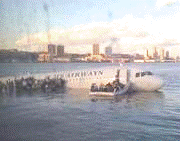Bird Strike Committee Proceedings
Date of this Version
8-2008
Abstract
The management of problem wildlife within the airfield environment is a difficult job and today’s biologists require as much information as possible. Bird censuses and actual strike events provide a good picture, but there is a valuable data set out there that has been overlooked, until now. Recent advances in commercially available, digital avian tracking radars have for the first time enabled biologists to track and evaluate near-miss events to increase the safety margin for our pilots and crew. As a part of the Department of Defense, Environmental Securities Technology Certification Program (ESTCP) Project: Integration and Validation of Avian Radars, tens of thousands of hours of bird tracks have been recorded. During the evaluation of many of these tracks, it was discovered that the radar software is capable of tracking and reporting near- miss events between birds and aircraft. This capability has motivated a study to characterize near-miss events and their importance for BASH management. This presentation will discuss the importance of near-miss information and how it can be used to enhance aviation safety. The definition of a near-miss event will be discussed, along with how this type of information can be used as a part of a facility bird strike management program. A review of some archived data sets will illustrate the potential for deriving risk assessments from near-miss information.


Comments
Abstract of paper presented at Bird Strike Committee USA/Canada Meeting, Lake Mary and Sanford, Florida, August 18–21, 2008.